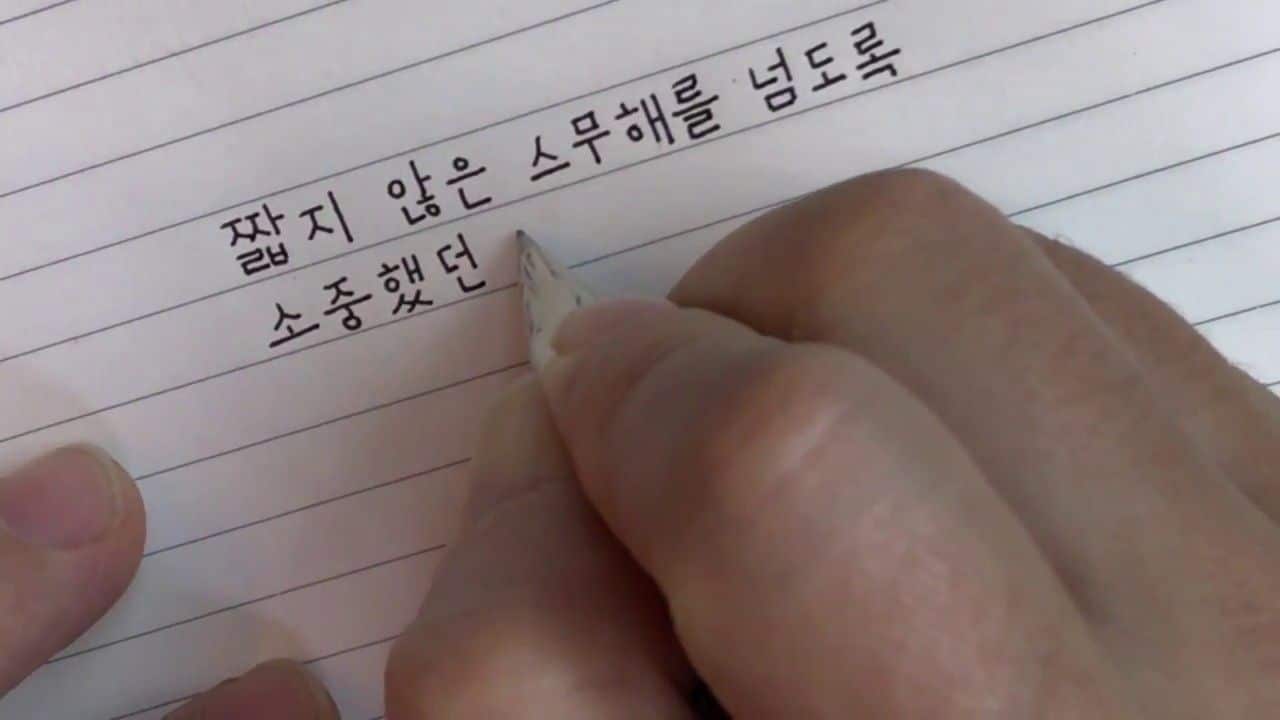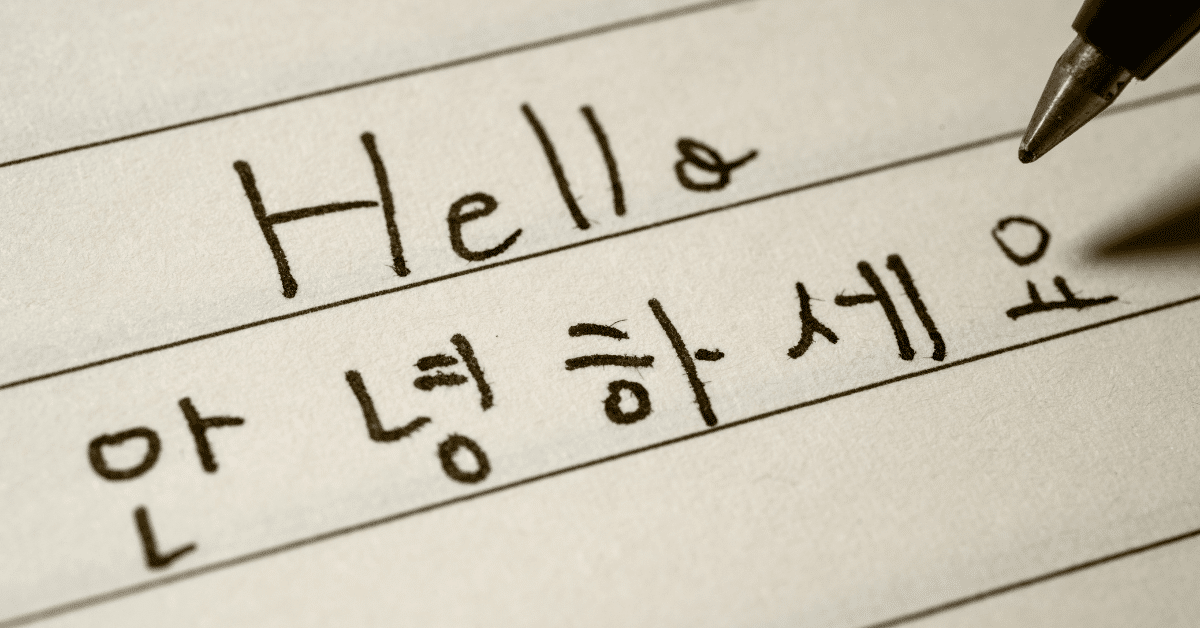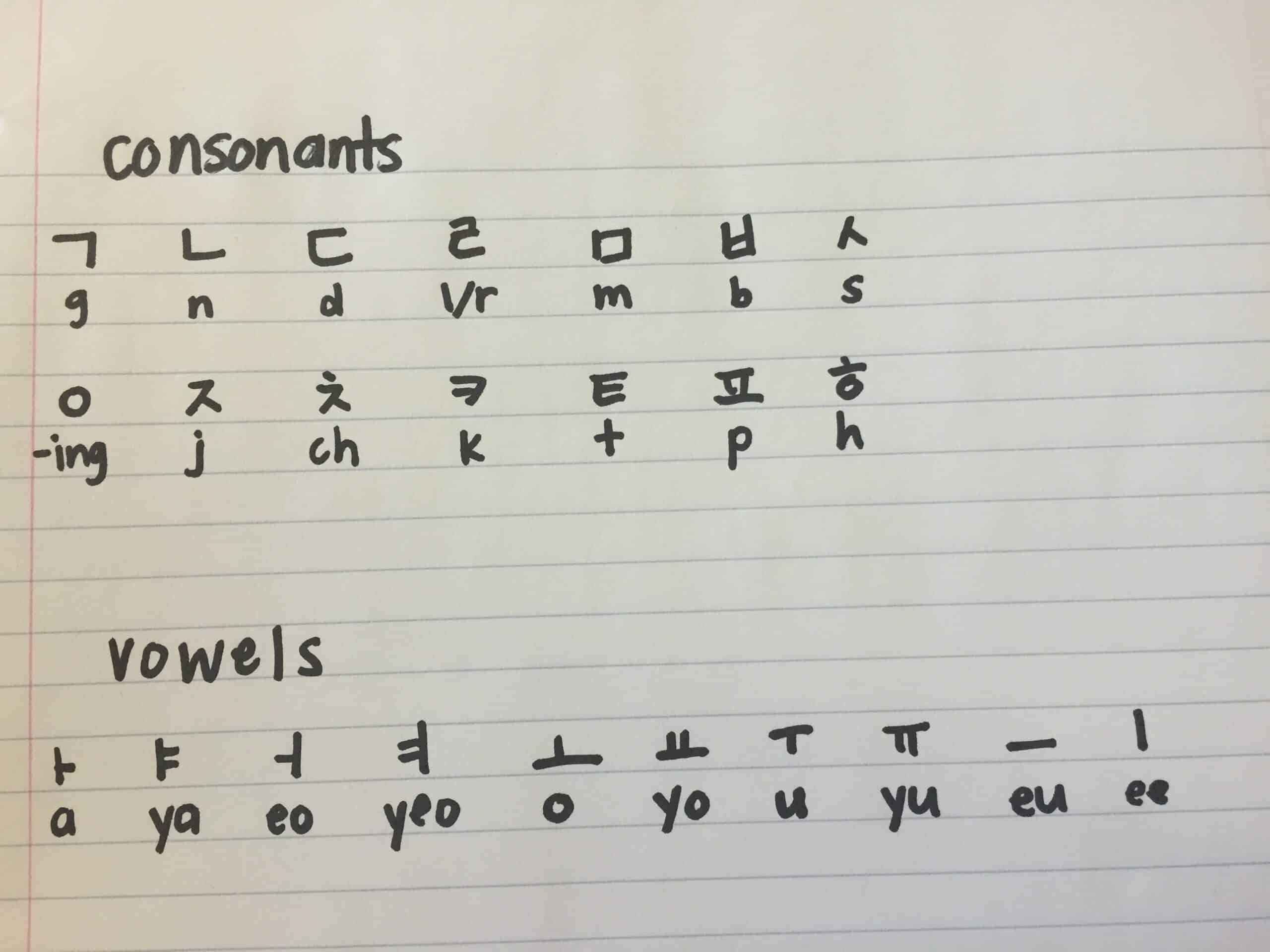
Korean Alphabet – A to Z
Everyday more people are looking to learn Korean and explore the charm of this Asian culture. Yet, before starting to learn the language is important to learn the alphabet. The Hangul Alphabet is what will allow you to learn Korean. Discover what is the Korean Alphabet from A to Z and start learning Korean.
1. What is Hangul Alphabet
Welcome to the exciting world of Hangul, the Korean alphabet. If you’ve ever been curious about the beautiful script that adorns Korean texts, you’re in for a treat.
Introduction to Hangul as the Korean Writing System
Hangul isn’t just any old alphabet; it’s the heart and soul of the Korean language. Unlike some other scripts that look like a complex puzzle, Hangul is refreshingly straightforward. It’s made up of simple, easy-to-learn characters that you can use to unlock the entire Korean language.
Historical Background and Significance of Hangul
Now, let’s hop into our time machine and zoom back to the 15th century. Korea was bustling with culture and knowledge, but there was one tiny hiccup—the writing system was a bit of a mess. Enter Hangul! Created in the 1440s during the Joseon Dynasty, it was like a linguistic revolution. It was designed to be accessible to everyone, regardless of their social status or education.
King Sejong’s Role in the Creation of Hangul
Speaking of revolutionaries, you can’t talk about Hangul without mentioning the main man behind it: King Sejong the Great. He believed in the power of language and literacy for his people. So, he assembled a dream team of scholars to create Hangul to make reading and writing extremely simple.
Hangul is more than just an alphabet; it’s a symbol of Korea’s commitment to education and communication. So, buckle up as we dive deeper into the world of Hangul and uncover its secrets.

2. Letters in the Korean Alphabet
Now that we’ve dipped our toes into the world of Hangul, it’s time to take a closer look at the stars of the show: the letters themselves.
Overview of the Consonants and Vowels in the Hangul (Korean) Alphabet
In Hangul, we have a neat and tidy set of characters for both consonants and vowels. None of that endless scrolling through your keyboard’s symbol menu! The Hangul alphabet is designed to be efficient and effective. Consonants and vowels work together in perfect harmony to create syllables. This make it surprisingly intuitive once you get the hang of it.
Hangul characters aren’t just random squiggles; there’s a method to the madness. Each character has a specific structure that reflects the way sounds are produced by your mouth. It’s like art meets science! We’ll break down how these characters are constructed so you can start recognizing them in no time.
Consonants in the Hangul Alphabet
- ㄱ – “g/k” sound
- ㄴ – “n” sound
- ㄷ – “d” sound
- ㄹ – “l/r” sound
- ㅁ – “m” sound
- ㅂ – “b/p” sound
- ㅅ – “s” sound
- ㅇ – “ng” sound (also silent when at the beginning of a syllable)
- ㅈ – “j/ch” sound
- ㅊ – “ch” sound
- ㅋ – “k” sound
- ㅌ – “t” sound
- ㅍ – “p” sound
- ㅎ – “h” sound
Vowels:
- ㅏ – “a” sound
- ㅓ – “eo” sound
- ㅗ – “o” sound
- ㅜ – “u” sound
- ㅡ – “eu” sound
- ㅣ – “i” sound
Diphthongs (Combined Vowels):
- ㅑ – “ya” sound
- ㅕ – “yeo” sound
- ㅛ – “yo” sound
- ㅠ – “yu” sound
- ㅐ – “ae” sound
- ㅔ – “e” sound
- ㅒ – “yae” sound
- ㅖ – “ye” sound
- ㅘ – “wa” sound
- ㅝ – “wo” sound
- ㅢ – “ui” sound
Examples of Basic Syllables Using Hangul Characters
Now, let’s get practical. We’ll put those consonants and vowels to work and create some basic syllables. Hangul is all about building blocks, and once you know the basics, you can start constructing words and sentences.
Here are some examples using the Hangul alphabet:
- 가 (ga) – This syllable combines the consonant “ㄱ” (g) with the vowel “ㅏ” (a).
- 고 (go) – Here, “ㄱ” (g) teams up with the vowel “ㅗ” (o).
- 다 (da) – Check out how the consonant “ㄷ” (d) pairs with “ㅏ” (a).
- 미 (mi) – “ㅁ” (m) and “ㅣ” (i) come together to form this syllable.
- 바 (ba) – Lastly, “ㅂ” (b) combines with “ㅏ” (a) to create this one.
3. Korean Vowels
Korean vowels are the essential building blocks of the language. Understanding and pronouncing these vowels correctly is your gateway to fluency.
Korean vowels are like musical notes, each with its distinct pitch. Let’s start with ‘ㅏ’ (a), which resonates like the ‘a’ in “father.” Then, there’s ‘ㅓ’ (eo), reminiscent of the ‘u’ in “butter.” Dive into ‘ㅗ’ (o), sounding like the ‘o’ in “go,” and encounter ‘ㅡ’ (eu), which mimics the French ‘eu’ in “jeune.” ‘ㅣ’ (i) mirrors the ‘ee’ in “see,” while ‘ㅔ’ (ae) combines the sounds of ‘e’ and ‘ae’ as in “pet.”
Here some examples:
- ㅏ (a) – Similar to the ‘a’ in “father.”
- ㅓ (eo) – Resembles the ‘u’ in “butter.”
- ㅗ (o) – Sounds like the ‘o’ in “go.”
- ㅡ (eu) – Similar to the French ‘eu’ in “jeune.”
- ㅣ (i) – Mimics the ‘ee’ in “see.”
- ㅔ (ae) – Combines the sounds of ‘e’ and ‘ae’ as in “pet.”
- ㅐ (ae) – Similar to the ‘a’ in “cat.”
- ㅛ (yo) – Resembles the ‘yo’ in “yogurt.”
- ㅕ (yeo) – Similar to the ‘yeo’ in “yeoman.”
- ㅑ (ya) – Sounds like the ‘ya’ in “yacht.”

Tips for Clear Pronunciation and Vowel Combinations
To avoid pitfalls, we’ve crafted a few tips to help you distinguish between similar-sounding vowels. For instance, ‘ㅓ’ (eo) and ‘ㅗ’ (o) can sound alike, but we’ll show you the tricks to set them apart.
Korean vowels love to mingle, creating harmonious sounds. Discover how vowel combinations work. ‘ㅏ’ (a) and ‘ㅣ’ (i) unite to form ‘애’ (ae), akin to “eye.” ‘ㅜ’ (u) and ‘ㅓ’ (eo) give us ‘워’ (wo), resembling “whoa.”
Sometimes, ‘ㅓ’ (eo) and ‘ㅗ’ (o) can be a bit tricky to differentiate. Imagine ‘ㅓ’ as the sound you make when someone surprises you with a joke, like “oh!” ‘ㅗ,’ on the other hand, is like the sound you make when you’re cheering at a sports game, “oooh!”
Korean vowels often join forces to create unique sounds. Take ‘ㅏ’ (a) and ‘ㅣ’ (i), for instance. When they unite, they form ‘애’ (ae), a bit like the English word “eye.” It’s as if ‘a’ and ‘i’ got together to say “ae” while pointing to their eyes.
Similarly, when ‘ㅜ’ (u) and ‘ㅓ’ (eo) team up, they create ‘워’ (wo), which sounds a bit like the English exclamation “whoa!” It’s like they’re saying, “Whoa, look what we made!”
Sign up for our offers
Exclusive discounts on your course with Cactus directly on your inbox!
4. Korean Alphabet Handwriting
Practical Advice on Writing Hangul Characters by Hand
Korean handwriting, or calligraphy, is not an art form but an integral part of mastering the Korean alphabet, Hangul. Writing Hangul characters by hand will then help you understand script better. It will also enhance your ability to read and communicate effectively in Korean. Here is some practical advice to improve your Korean handwriting.
Stroke Order for Consonants and Vowels
Stroke order is crucial in Korean calligraphy. When writing consonants like ‘ㄱ’ (g/k sound) or ‘ㄷ’ (d sound), following the correct stroke order ensures that your characters are clear and legible. For example, when writing ‘ㄱ,’ start with a short horizontal stroke from left to right, followed by a vertical stroke from top to bottom.
Vowels, such as ‘ㅗ’ (o sound) or ‘ㅏ’ (a sound), need fluid strokes. For ‘ㅗ,’ create a smooth curve from top to bottom, resembling the shape of your lips when pronouncing the sound.
Avoiding Common Mistakes
To maintain neat handwriting, be mindful of common mistakes such as excessive pressure on the pen. It can lead to smudges or uneven lines in your characters. Practice writing with a light touch to achieve clean and well-defined characters.
Consistent Spacing and Alignment
Consistency in spacing and alignment is essential for legible Korean handwriting. Maintain even spacing between characters to avoid crowding. That can make your writing difficult to decipher. Additionally, align characters both horizontally and vertically.
Resources and Tools for Practicing Korean Handwriting
Improving your Korean handwriting involves practice and the right tools. Online handwriting practice platforms offer interactive exercises. Then you can trace over characters and receive instant feedback on your form. Traditional calligraphy brushes and ink are also excellent for those who want to explore the artistry of Korean handwriting.
5. Korean Alphabet Pronunciation
Discover the best places to improve your Korean Alphabet pronunciation. From websites, to language classes to YouTube channels. Plenty of tips for you to master the Hangul Alphabet pronunciation.
Guidance on Correct Pronunciation of Hangul Consonants and Vowels
Pronunciation is the key to effective communication in any language. That said, Korean is no exception. Understand the nuances of Korean alphabet pronunciation, focusing on both consonants and vowels. Clear pronunciation is essential for being understood by native speakers. It will build your confidence in speaking Korean.
Consonant Pronunciation:
- ㄱ (g/k sound): Pronounced like the ‘g’ in “go” when at the beginning of a word. When it appears elsewhere, it’s closer to ‘k,’ like the ‘k’ in “sky.”
- ㄷ (d sound): Similar to the ‘d’ in “dog.”
- ㅁ (m sound): Like the ‘m’ in “moon.”
Vowel Pronunciation:
- ㅓ (eo sound): Similar to the ‘aw’ sound in “saw.”
- ㅗ (o sound): Like the ‘o’ in “go.”
- ㅡ (eu sound): Similar to the ‘u’ in “truth.”
Recommended Websites and Audio Resources for Improving KoreanAlphabet Pronunciation
To refine your pronunciation, take advantage of Korean resources. Start learning Korean in a group with a native-speaking teacher and complement to speed up your learning. Websites such as Talk To Me In Korean and How To Study Korean are great options. Both offer audio lessons where you can hear native speakers pronounce words and phrases. YouTube channels such as sweetandtastyTV provide valuable pronunciation tutorials and language tips.
Tips for Enhancing Your Spoken Korean Using the Hangul Alphabet
- Practice Speaking Aloud: regularly read Korean texts or books out loud. This practice helps improve your pronunciation and fluency.
- Language Exchange Partners: to connect with native Korean speakers or language exchange partners. A great option to converse in Korean. Hearing and mimicking native pronunciation is invaluable.
- Use Language Learning Apps: with mobile apps such as Duolingo. Pronunciation exercises to enhance your Korean speaking skills on your own.
Example:
- Pronunciation of ‘ㄱ’ (g/k sound) and ‘ㅇ’ (ng sound) in Korean words:
- “강아지” (gangaji) – Pronounced as “gahng-ah-jee” which means “puppy.”
Don’t forget, these are great complements to a structured Korean course. By following these tips, you’ll improve your Korean pronunciation skills. You will become a more confident and effective communicator in Korean. Practice, patience, and persistence will be your allies on your journey. Start by mastering the Korean alphabet and pronunciation.
Korean Alphabet – A to Z and Next Steps to Learn Korean
Starting your Korean language learning journey can be somewhat daunting. But starting with the basics such as Korean Alphabet is a great way for you to start. The best next step is joining a Korean course to get you moving. The help of other students and tutors will make it much easier.
Why not start learning Korean with our Korean lessons. Or one of our Korean courses abroad. Cactus offer a range of Korean classes from beginners to advanced. With weekly lessons, you can choose the best option for you.

 French
French German
German Italian
Italian Spanish
Spanish Arabic
Arabic Cantonese
Cantonese Czech
Czech Croatian
Croatian Danish
Danish Dutch
Dutch English
English Greek
Greek Hebrew
Hebrew Hindi
Hindi Japanese
Japanese Korean
Korean Norwegian
Norwegian Polish
Polish Portuguese
Portuguese Russian
Russian Swedish
Swedish Thai
Thai Turkish
Turkish Ukrainian
Ukrainian